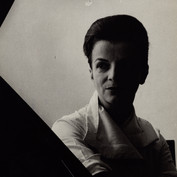Lygia Clark

Belo Horizonte, Brazil, 1920 —
Rio de Janeiro, Brazil, 1988
A member of the Neoconcrete group, Lygia Clark broke the frame of the painting in the late 1950s. In 1958 Modulated Spaces and Units, the border that isolated the work from the world ceased to outline the painting and presented itself by strolling the monochromatic surface wooden boards. In Casulos, from 1959, the work is projected from the wall to the third dimension. This rupture movement with two-dimensionality culminates in Bichos, developed between 1960 and 1964, manipulable sculptures, made with aluminum plates joined by hinges. The sculpture will interact with the participant to acquire a shape. In the Trepantes series (1964-65), malleable sculptures of metal or rubber are wrapped around wooden logs or stones and also invite participation.
As of 1966, Lygia Clark uses ephemeral and prosaic materials such as plastics and stones, which more vehemently avoid exposing her works as objects for contemplation. In the 1967 exhibition “Nova Objetividade Brasileira”, Lygia Clark presents the interactive work O eu eo tu / Roupas-corpo-roupa, from the series Nostalgia do Corpo (1966), reaching the paroxysm of the immanence of the act since, manipulating its propositions, the participant felt his body awaken. The strategy of altering sensory perception continues in propositions that use plastic bags filled with air, masks with compartments full of stimulating herbs for smell, glasses that alter vision with mirrors or heavy gloves to stimulate touch. The result is a heightening of the senses or an invitation to introspection.
Lygia Clark’s investigations have turned, since 1966, more and more to the psychic world, and funnel her audience. From 1973, the artist began to experiment with her proposals with her group of students at Sorbonne, focusing on sensory and collective experiences of great impact on the deconditioning of behaviors and inter-subjective relationships. Back in Rio in 1976, he dedicates his “relational objects” to one person at a time, in a therapy based on the potential that his simple objects, made with stones and plastics, would have to recompose the relationship of the participant (now patient) with his body, and thus treat psychic disorders.
What is an art gallery? - Peter Cohn
Peter Cohn, founder of Dan, narrates this video with works by Mira Schendel, Lygia Clark and Amilcar de Castro.
Women Ahead
It's never too late to pay homage to women. On the last day of March 2020, Dan Galeria presents the collective Mulheres à Frente, bringing together Brazilian artists of extreme relevance and participation in our history of art.
